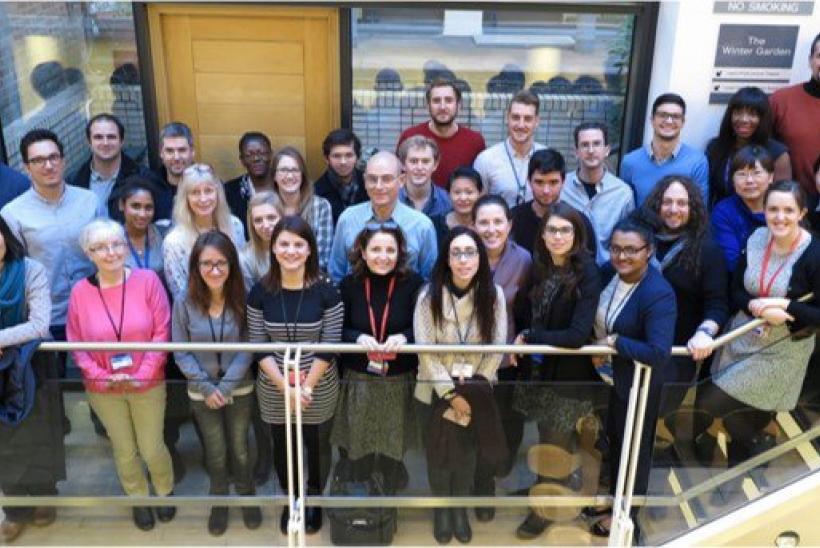最新基因疗法提升脊髓性肌萎缩症SMA的治疗前景
Researchers and doctors at GOSH have long been at the forefront of developing new treatments for Spinal Muscular Atrophy (SMA) and new research this year is helping us understand how Zolgensma, a gene therapy, can help.
SMA affects the motor neurons, i.e. cells in the spinal cord, making muscles weaker and causing problems with movement, breathing and swallowing. When it develops in babies and toddlers, it can significantly reduce life expectancy. It is the most common fatal recessive genetic condition and in the UK in 2019, around 70 babies were born with SMA type1, the most severe form.
Until recently, treatment was limited to support of the patient and family but in 2020, after GOSH was involved in a highly-successful multi-centre clinical trial, Nusinursen (Spinraza) was licensed for use in the NHS for the first time.
But teams at GOSH are still working round the clock to develop better treatments for our patients with SMA. Recent developments have seen a gene therapy called Zolgensma become available on the NHS for babies under one year old, but we know that treatment at the very earliest opportunity is crucial to stop this condition in its track.
Striving for better for our patients
We’re now pleased to share the results of the STR1VE-EU research project that has confirmed that Zolgensma - an adeno-associated viral (AAV) gene therapy - can lead to significant improvements in children with more advanced SMA.
There was a US arm of this research (STR1VE-US) that had indicated that Zolgensma could improve survival and quality of life when given to very young children, with less severe symptoms of SMA. For example, the US trial had no children who needed ventilation or feeding support when the trial started, while the EU arm did. The EU side of the research is the first to confirm the hope that this gene therapy can be effective in babies (usually aged less than 6 months) already showing symptoms of SMA.
In order to better characterise the effect of this new type of gene therapy in older (and therefore heavier) children, Novartis will support a further clinical trial to be sure of the risks and benefits in older children, with even further progressed disease.
Treatment options for SMA have come a long way in the last 5 years. Where previously we had limited or no treatments for our children, these new treatments mean that we can stall the progression of the disease for our patients. Not all children with SMA need ventilation but we’ve seen children who needed almost all-day ventilation go to ventilation only overnight, or some children come off ventilation all together. We are pleased to see that gene therapy is now also available for SMA1 children in UK who weigh up to 13.5kg. Patients who receive Nusinursen or Zolgensma will still need to remain under neuromuscular care, but life now looks a lot brighter for them. GOSH is a specialist centre for SMA and it’s only through our patients’ and families’ commitment to research and trust in us that we can make these breakthroughs. We are forever grateful to them.
Prof Mariacristina Scoto, Consultant in Neuromuscular Translational Research at GOSH and sub-investigator of the STR1VE EU trial
A lasting legacy for SMA research
SMA is a severe condition that can prove fatal and, due to the kind generosity of patient families, the team have also been able to study samples from children who sadly died while on the STR1VE trials, unrelated to the treatment. For this work, the GOSH and UCL GOS ICH teams worked with experts from Ohio State University in the USA.
This means that the team can, for the first time, establish where this brand-new gene type of gene therapy treatment travels to, and accumulates, in the body. This is crucial to develop AAV gene therapies for other conditions.
Our families understand the power of research and, owing to their kind generosity, we’ve now been able to understand how much of an injected AAV gene therapy gets into different parts of the body, like the brain or heart. AAV technology is at the cutting edge of gene therapy and will be used for more and more conditions. The information gathered in this study will be of value to researchers involved in a wide variety of conditions, from brain diseases, to metabolic conditions, to muscular dystrophies. We cannot overstate the debt of gratitude we offer to our research families.
Professor Francesco Muntoni, Principal investigator of the Strive EU trial and second author of the Strive EU Lancet Neurology manuscript, Director of the Dubowitz Neuromuscular Centre at GOSH and UCL GOS ICH
This first study of AAV9 gene therapy distribution is was a collaboration with GOSH clinical academics and led by Arthur Burghes at Ohio State University
All research at Great Ormond Street Hospital is underpinned by support from the NIHR GOSH BRC.


